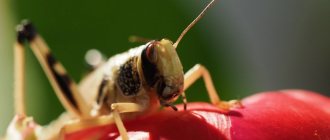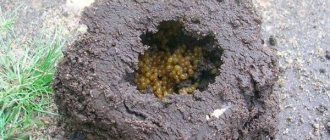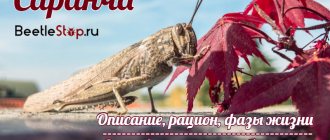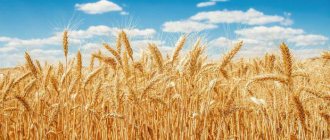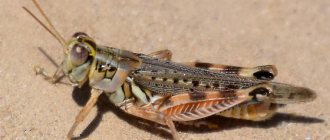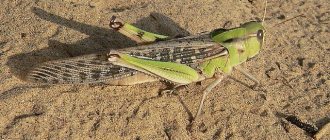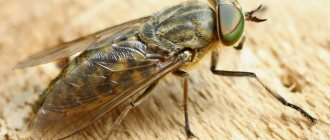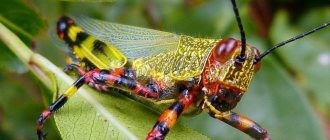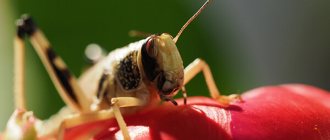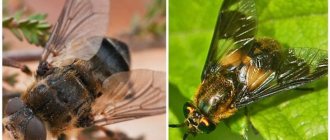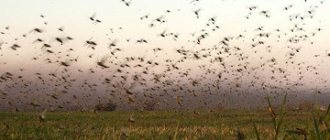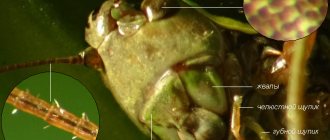- Description of locusts
- Habitats and food
- How to fight locusts, effective methods
- Differences between locusts and grasshoppers
Not everyone knows what locusts are. However, this arthropod insect, which belongs to fairly large representatives of the order Orthoptera, can completely destroy crops. And it is the main threat to grain crops, vegetable plants and other cultivated plants.
In past centuries, after the invasion of these insects from the family of true locusts, fields were left completely bare. Their gluttony was described in the works of many ancient writers. But over time, effective methods have been found to combat these pests.
What locusts look like, what plants they damage and how to fight them - all this will be discussed below.
Description of locusts
Many have heard about how huge hordes of locusts literally destroyed the entire crop in the fields in a matter of minutes. What does this pest look like?
The body length of this voracious insect can range from 4.5 to 19.5 cm, its hind limbs are bent at the “knees”, and these limbs are much larger than the middle or forelimbs.
A pair of hard elytra cover half-transparent wings, almost invisible when folded. Sometimes the wings can be covered with patterns.
The antennae of this insect are short, much smaller than others. The head is larger than that of other individuals of this family, the eyes are larger than average.
Male locusts make specific sounds, how do they do it? It turns out that there are serrations on the thighs of the locust's hind limbs, and thickenings on the elytra. These parts rub against each other, resulting in a chirping sound that can vary in sound.
The body color of pests does not depend on their genes, but solely on the environment in which the locust lives. And even one offspring that grew up in different regions may have different body colors. Also, the color of the body can be determined by the shape of its development.
Young males and females can be bright emerald, yellow, gray or brown, which allows the pests to camouflage themselves among the surrounding vegetation. They also have pronounced differences by gender.
When individuals enter the gregarious phase of their development, their colors are already the same for all insects, and it is also impossible to distinguish them by gender. A flock of these insects moves briskly: these pests cover up to 100-115 km per day.
Limbs
The hind legs of the grasshopper are slightly longer than those of the locust. With their help, this insect moves and pushes off when attacking prey. The forelimbs help to grab branches when moving through trees, and in addition, they are involved in catching the “future dinner”.
The front legs of a locust are much weaker than those of a grasshopper. They do not play a special role in the life of this insect; their main task is to create support when moving. And the locust's hind legs are not as long as those of its fellow, but it is thanks to them that the locust can jump so far.
Habitats and food
Various species of this pest can be found in almost any region of the globe (except the South Pole). Some species live in thickets of grass next to any bodies of water.
Others prefer desert or semi-desert climatic zones; they live in rocky areas where shrubs or grass grow.
What do locusts eat and how much can they eat? While the insect lives alone, its appetite is small. If an individual lives in one place, then it eats no more than 200-250 g of food of plant origin in its entire life.
But the locusts' appetite increases significantly the moment these pests flock together. The flock, flying along green spaces, eats everything in its path. After its invasion, bare earth remains without signs of any vegetation. Moreover, the flock usually stops for food in the morning and evening hours.
A swarm of these pests has no preferences in food - they destroy with the same appetite both thickets of reeds and reeds, as well as fruit trees and vineyards.
They also destroy plantings of any grain crops. During long flights, these insects can destroy weaker relatives, making up for the lack of food and water.
How to kill a cricket?
If you find a cricket, try killing it with a fly swatter. In the end, what you want is to kill them. If you want, you can try to catch them.
Interesting materials:
What is amoxicillin 500 mg for? What is the Assembly for? What is a bodysuit for and how to wear it? Why were turtles taken on the ship? Why Brushing? Why was the oprichnina created? Why was the Warsaw Pact Organization created? Why do they give analgin injection? What and how are patch panels used for? What is Assonance used for?
How to fight locusts, effective methods
In areas where there is a high probability of these pests appearing in large numbers, deep plowing of the soil is usually carried out to destroy the eggs laid by the locusts in the ground.
In the spring, repeated digging and harrowing should be carried out in order to destroy clutches of eggs that the locusts could lay after autumn plowing.
During the summer season, swarms of locusts can only be effectively controlled using chemical agents.
In areas where a large number of larvae of this insect are found, pesticides are used, the validity of which is at least a month from the moment of spraying. To poison the soil and destroy pests, Karate, Confidor and similar preparations are usually used. Also suitable for combating locusts are chemicals designed to kill the Colorado potato beetle.
A systemic chemical such as Clotiamet VDG, when sprayed, protects plants from locust attacks for 19-22 days. The main positive quality of this product is the possibility of using it together with mineral fertilizers, growth stimulants or other drugs that protect plantings from pests.
The insecticide "Damilin", which is also successfully used to combat locust larvae, slows down the development of insects at this stage, and also prevents the formation of the chitinous cover of the larvae, which leads to the death of the pests. This drug is the least toxic.
Reproduction and lifespan
Locusts are oviparous insects and reproduce sexually. To attract a female, an enterprising male produces a specific hormone, by the smell of which the female searches for a suitable partner.
Attracted by the smell, she finds the male and tries to get as close to him as possible. The male individual attaches to the female and tries to deposit a capsule with sperm into the part of the posterior end of the abdomen (ovipositor). Mating often takes a long time and can last up to 13 hours.
The female leaves the ovipositor directly in the ground and covers it with a foamy liquid, which solidifies into a solid cocoon. One such clutch can contain 60-80 eggs. During her life, the female makes from six to twelve clutches, which contain up to four hundred eggs.
After twelve days, white larvae crawl out of such a cocoon and immediately begin to feed intensively. The larva goes through several stages of development and turns into an adult specimen in 35-40 days.
The lifespan of locusts depends on the climatic conditions of their habitat and can range from 7-8 months to 2 years. In areas with harsh winters, locusts die with the onset of frost. an insect similar to a locust on your territory , you should water the area as often as possible, since fillies do not reproduce well in high humidity.
It is best to treat plants with a liquid specifically designed to combat these insects. Animals that eat poisoned leaves should die within 2-3 days. Particular care must be taken to identify places where eggs may be laid, and try to prevent the appearance of larvae.
Differences between locusts and grasshoppers
Many people believe that grasshoppers and locusts are very similar to each other. However, these insects have very serious differences that should be discussed. What is the difference between a grasshopper and a locust?
| The main differences between grasshoppers | The main differences between locusts |
| These insects belong to the grasshopper family, suborder of long-whiskered | This pest belongs to the locust family, suborder of the short-whiskered |
| Elongated antennae and limbs | Antennae and limbs are short |
| These individuals are predatory insects | Locusts are herbivorous pests, although sometimes their representatives feed on their weakened “comrades” |
| Grasshoppers sleep during the day but are very active at night | Active only during daytime |
| Do not harm cultivated plants | These pests cause enormous damage to agriculture |
| These insects lay their eggs in plant shoots or inside the bark of trees. | The eggs of these pests can be found in the soil or in fallen leaves. |
Unfortunately, it is possible to fight locusts at all stages of their development only with the help of pesticides, which are quite toxic and can accumulate in cultivated plants and the fruits of fruit trees.
Therefore, more attention should be paid to carefully digging up the soil in the autumn and spring to destroy the eggs of this pest.
Kinds
The most famous types of locusts are:
1. Migratory or Asian.
It is found in large quantities in European countries and in countries located in western Asia, in the Mediterranean territories of the African continent, in the countries of East Asia. The size of the body in an adult individual is usually 40-60 mm.
The wings have a barely noticeable grayish tone and darkened veins. The color follows the shades of the surrounding area - emerald-greenish, grayish-brownish or sand. The hind limbs of these insects are darker in color compared to the body.
2. Moroccan.
This species is distributed in the Mediterranean climate zone of northern Africa. You can see insects in the southern part of European countries, as well as countries located on the Balkan Peninsula and in southern Russia.
Adults are not large in size, in most cases they are no more than 20 mm, the color is usually inconspicuous, grayish-brownish. A distinctive feature by which they can be recognized is a light-colored pattern resembling a cross on the back and dark spots randomly located throughout the body.
3. Italian.
The main place of settlement is the countries of the Iberian and Apennine Peninsulas. You can meet insects in areas west of the Urals and in Asian countries, in the Altai Territory and in the countries of the Arab East.
The maximum size to which an adult insect grows is 40 mm. Individuals of the Italian locust have a brick or brownish color; lightish specks or stripes are clearly visible on the back.
4. Siberian filly.
It can be found in almost all regions of the Asian part of the Russian Federation (except for permafrost areas) and in Kazakhstan. A large number of Siberian fillies can be found in the northern territories of Mongolia and China, and the mountainous areas of the Caucasus. Mature individuals are relatively modest in size; their length is not often more than 25 mm. The color of the insects is brown with a brownish tint or a khaki shade.
5. Egyptian filly.
This species can be found in European countries, northern regions of the African continent, and Middle Eastern countries. This is one of the most impressive insects. Females can grow up to 60-70 mm. Male individuals are smaller, their body size is no more than 40-45 mm.
These locusts are usually painted the color of a mouse or the color of wet sand. The hind legs of the insect have a bluish tint, sometimes with the addition of yellow-red. A characteristic feature is clearly visible lines - black and white, they can be seen on the bulging eyes.
6. Blue-winged filly.
It lives in steppes and forest-steppe regions of Asia and Europe, the Caucasus, western regions of Siberia and Kazakhstan. Does not apply to species whose size is large. 20 mm is all that a pest with beautiful wings can grow to. The color of the insect is amazing.
The wings have a turquoise or rich blue color, on which a fancy pattern of thin strokes of dark color is clearly visible. The hind legs have small spines of a light shade and are tinted light blue.
7. Rainbow Locust.
Lives on the island of Madagascar. This is a very spectacular and attention-grabbing individual, but at the same time, it is extremely poisonous. All her organs are literally saturated with toxic and noxious substances, since she only eats plants that produce poisonous juice.
Favorite food is milkweed leaves and fruits. Her appearance is admirable - the whole range of colors is gathered on her wings, and this is understandable, because she lives among bright vegetation. The beauty has impressive dimensions - up to 70 mm.
What is the difference between a grasshopper and a locust
Surprisingly, locusts still cause great damage to humans today. In the article dedicated to the pest, you can read about how to stop attacks of its various types.
So, we have described a dangerous agricultural pest - the locust, photographs of which you can see above.
The grasshopper is an arthropod insect that belongs to the superorder New-winged insects, the order Orthoptera, the suborder Orthoptera, the superfamily grasshopper (lat. Tettigonioidea).
The Russian word “grasshopper” is considered a diminutive of the word “smith”. But, most likely, it has nothing to do with the forge, but comes from the Old Russian “izok”, meaning “June”. Almost 7 thousand known species of grasshoppers live on every continent except Antarctica. Due to such diversity, even an experienced entomologist cannot always determine the species identity of a particular individual.
The complex hearing apparatus, that is, the grasshopper's ears, is located on the shins of the insect's front legs. Thus, we can say that the grasshopper hears with its feet. The oval membranes that are located on both sides of the lower leg act as eardrums. In some species of grasshoppers, the membranes are open, in others they are closed with special caps. The structure of the hearing aid consists of nerve endings, muscles, and sensory cells. The structure also includes 2 branches of the trachea, which approach the eardrums.
Grasshoppers have noticeable sexual dimorphism: females are much larger than males and have a sickle-shaped or straight, arrow-like ovipositor. The lifespan of a grasshopper, including the egg stage, is only one season.
In conditions of autonomous maintenance and lack of nutrients, grasshoppers have even been observed in cannibalism, that is, eating their own kind. A simple experiment showed that if you put several of these insects in a closed jar and leave them without food for a couple of days, the group will eventually suffer losses among their relatives.
It may seem surprising, but if the grasshopper does not receive its “dose” of protein and salts from ordinary food, then it does not disdain to feed on feces and carrion, and also eats its weaker relatives with appetite.
Locusts are a small but formidable scourge of humanity. Peoples engaged in agriculture and cattle breeding have suffered more from it since ancient times.
A swarm of insects could destroy all fields, dooming the people living there to starvation. In biblical times, it was mentioned in the tale of Moses, and since then it has become a harbinger of troubles and misfortunes.
They also said that the appearance of locusts is a sign of the gods calling for repentance.
The ancient Chinese considered this insect in the house a good sign, but large swarms were a harbinger of serious troubles. Middle Eastern myths associate locusts with the moon goddess.
Appearance of locusts
Another name for these insects is locusts. The locust family includes several species.
In terms of its abundance, the locust ranks first in the order of Orthoptera insects.
The appearance of different species differs and depends on the age and habitat of the insect. The older the locust, the darker its color.
Locusts are interesting because they can be in the stage of a solitary insect or a gregarious one. It depends on the amount of food.
Insects are so different from each other in appearance and in other characteristics that previously they were even classified as different genera.
During the solitary phase, when there is enough food for the growth and development of the population, the locust insect leads an inactive lifestyle, has a protective coloration and has pronounced sexual dimorphism.
If food becomes scarce, insects lay so-called “marching” offspring, which gather in large flocks.
To the description of the locusts of this phase, it must be added that they are larger in size, they have longer wings adapted for flight, their coloring is brighter and more contrasting, their lifestyle is much more active, and sexual dimorphism is almost absent.
But she has shorter antennae, a body length of 6-20 cm, other hearing organs (they are located on the sides of the abdomen, in its first segment) and a shorter ovipositor.
The locust's head is large, with powerful jaws. The lower wings are transparent, usually of a greenish tint, covered by upper hard elytra.
Females are larger than males. Like grasshoppers, locusts can also be classified as “musical” insects.
Some species of these insects are very bright and beautiful, as can be seen from the photo of the locust.
But you should not perceive this insect as too cute and safe - the locust may well bite.
Locust habitat
There are a huge number of locust species, and about 600 of them live in Russia, mainly in the southern regions.
The steppe locust lives in Asia, North Africa, and Europe. Different species live in different regions.
The borders of the Sahara, the Indo-Malayan archipelago, New Zealand, Kazakhstan, Siberia, Madagascar are all habitats for locusts.
Large nesting centers are located in the delta of the Amu Darya River, near the Northern Caspian Sea and Dagestan.
The northern regions are also habitats for locusts, but the population density there is much lower than in the south.
Small flocks fly 20-40 km per day, and large flocks can travel 200 km. Per day.
The southern regions of Russia have repeatedly suffered from locust invasions. So in 2010, the Astrakhan region almost lost 50 hectares of crops, and in the Volgograd region, locusts caused damage to 12 districts. People are fighting locusts, but it is very expensive.
Locust lifestyle
A single species of locust (filly) lives and feeds, relatively without causing harm to plants.
When there is a shortage of food in its habitat, such a locust lays eggs, from which a gregarious individual hatches.
This species is more adapted to long flights and gathers in huge flocks of up to hundreds of millions of insects.
On their way, they devour all plant food. A small grove or field will be eaten up in a matter of hours. Locust activity hours occur during daylight hours.
If the lifestyle of a single insect is sedentary, then swarms of locusts are very mobile and behave as a single organism.
There have been recorded cases of swarms of locusts flying across the ocean, which is about 6 thousand kilometers.
From afar, huge flocks look like a cloud with an area of several thousand square meters.
Some solitary insects form groups of 6 individuals. They contain one male.
Locusts feed on many types of plants, and unfortunately for people, they also feed on agricultural crops.
She eats a large amount of food per day, approximately equal to her own weight.
And the offspring of one individual is enough to eat enough grass in a season to feed two sheep. Fields, vegetable gardens, forests, meadows - all this can be eaten by a swarm of locusts.
The photo shows a swarm of locusts
Sometimes locusts also attack orchards - for example, they will eat grapes, starting with the leaves and ending with the bark and berries.
The vegetation of reeds, reeds, hemp, flax, buckwheat, cereals - all this is used as food for the locusts.
In addition, if there is a lack of food, it can attack the thatched roofs of houses, and on a long journey without food, it can eat its weaker brothers.
Reproduction and lifespan of locusts
The male initiates mating - he secretes a special hormone around himself, thus attracting females.
When the female approaches, the male jumps on her and attaches himself to her. Its purpose is to deposit a spermatophore at the base of the female's ovipositor. The process is quite long, mating can take up to 14 hours.
Photo of locusts mating
After mating, the female lays an ovipositor in the ground. To protect the eggs, the female secretes a sticky liquid that hardens around it and forms a strong cocoon.
This egg capsule contains about 50-70 eggs, which develop over 12 days. Over the course of her life, a female locust will lay 6-12 clutches.
The larvae that emerge from the eggs molt several times; there are 5 stages of transformation. The locust cannot be called a caring mother; perhaps the only thing it does for its offspring is to allow the larvae to eat the wings that have become unnecessary to it.
The lifespan of locusts varies greatly. An insect can live 8 months, or maybe 2 years.
What locusts look like, what plants they damage and how to fight them - all this will be discussed below.
What are they chattering about?
Orthoptera and Hymenoptera make characteristic sounds to attract females. Everyone has their own sound apparatus. Due to its development in crickets, insects are distinguished by a wider sound range. By their chirping one can judge not only the mating process. Insects also make sounds while protecting their territory.
To listen to the chirping of crickets, you only need to go out of town. They can sing at any time of the day until they wait for their mate. Cicadas require warm weather. The hotter it is outside, the more actively they sing. Therefore, the chirping of these insects is more likely to be heard on a hot summer day.
Differences between crickets and cicadas can be found in the way they chirp. The acoustic organ of crickets is represented by a special structure of the elytra. The principle of their operation is similar to playing the violin. The elytra have a large number of veins and folds, which are arranged in a chaotic manner. When they hit each other, certain vibrations are created that can be heard by the human ear.
Cricket
Their opponents' ability to play music is also their weapon. The sound volume of insects can reach even 100 dB.
Characteristic sounds are heard due to the presence of special membranes located at the base of the abdomen. The chirping sound is produced by the vibration of an acoustic organ.
You can determine who is chirping: cicadas or crickets by the strength of the sound. In the former, the strength of the chirping can even drown out a loud conversation of a person and they can be recognized at a distance of about 800 m. The latter have a more subtle, but multifaceted sound.
The benefits and harms of locusts
The greatest damage is caused by swarms of locusts that destroy fields and plantings. However, the average person, who does not care about the safety of the crop, is more interested in the answer to the question of whether locusts bite. The insect eats exclusively plant food and does not bite humans, unlike its fellow grasshopper.
An equally pressing question is whether locusts are eaten. Orthoptera are the most commonly consumed insects after ants. In African countries they fry it and mix it into flat cakes. Arab women several centuries ago could prepare 2 dozen dishes from locusts. Culinary recipes have lost their relevance due to a shortage of ingredients.
In California, during locust outbreaks, entire feasts were held. The captured insects were soaked in a marinade, then crushed and prepared into soups. The Japanese marinate it in soy sauce and fry it. In a word, there are many recipes for cooking locusts, but not everyone can appreciate its taste, not so much because of inaccessibility, but because of disgust.
Comparison of Grasshopper and Locust
Check out the table below to learn about some of the main differences.
| Grasshoppers | Locust | |
| Size | Approximately 2 inches long | Approximately 2-3 inches long |
| Lifespan | 1 year | 3-6 months |
| Colors | Green, olive, brown, yellow and red | Green, black and brown (depending on population) |
| Number of species | 11000 different types | 19 different species (all of which belong to the grasshopper family) |
How to distinguish a locust and a grasshopper - which is larger in size, the characteristics of each insect
It is known that locusts are pests and are ready to devour everything in their path. The same cannot be said about the grasshopper. These insects are difficult to distinguish from each other, which often leads to the destruction of grasshoppers in the garden plot. But they play a positive role in the summer cottage. Since they are predators, their diet often includes harmful insects such as aphids, Colorado potato beetles, etc. In order not to kill a beneficial predator, you need to know the difference between a locust and a grasshopper.
- Description of grasshopper and locust Feeding methods
- Habitats
- Mustache length
- Tables for determination
How to identify an insect?
In order to determine which superfamily an insect belongs to, it is necessary to know the description of its main body parts. Conventionally, it is divided into three parts - head, chest and abdomen. It is necessary to carefully examine and pay attention to the distinctive features of the insect, namely: the size, type and length of the antennae and limbs. To identify an individual, you can turn to an electronic identification guide, which will tell you how to correctly distinguish a grasshopper from a locust.
Tables for determination
The key consists of various tables in which the type of family members can be determined by complex external characteristics. Using these tables, you can easily identify the identity of the insect. The determinant indicates the characteristic features with the assignment of numbers. Numbers in brackets indicate opposite features. You can conduct a visual inspection of the insect and follow from one sign to another. For example, the presence of a mustache or other features.
By looking for external features, you can achieve your goal - to determine the species. Next to the name in Latin there will be an inscription with the name of the family in Russian. By clicking on the link, you can see a color image of the insect and specify the name. If the data that you found in the key matches the external characteristics of the insect, then the identification of the species of the individual (locust or grasshopper) can be considered successful.
Thus, it is not so difficult to correctly distinguish a pest from a predator found in a garden plot. Knowing the structural features of the body will help determine the species. If in doubt, you can use an electronic identifier to help identify the insect.
Source
How to destroy locusts in the garden
While researchers are busy in laboratories, the locusts do not sleep. And if the average gardener is not yet able to cope with the invasion of a multimillion-dollar flock, he is quite capable of eradicating rare settlers.
Reminder on how to deal with locusts:
- Having discovered an adult or oviposition, immediately destroy it mechanically.
- Dig the soil deeply at the end of summer to find and neutralize locust egg capsules. During the same period, you can burn plant residues and stubble. This will eliminate locust eggs that are on the soil surface. But as a rule, most egg capsules are located at a depth of 5-7 cm, so burning will not help completely get rid of egg-laying eggs.
- Chemical soil treatment is most effective before sowing seeds and planting plants. To do this, use products from the group of pyrethroids: “Taran”, “Caesar”, “Karate”, “Fastak”. The working solution is prepared in accordance with the instructions. If the treatment is carried out at the end of May, June, when the locust larvae are 2 or 3 instars, organophosphorus preparations are additionally added to the solution.
- During the period of invasions, imidacloprid-based products are used to protect plants: “Image”, “Tanker”.
- In late autumn, agrotechnical measures are carried out, including plowing and cultivation.
To combat locusts, natural enemies are also used: reptiles, blister beetles, birds.
